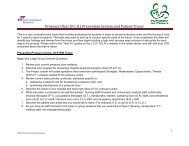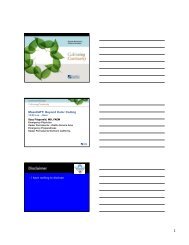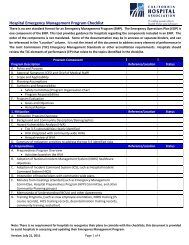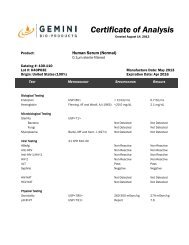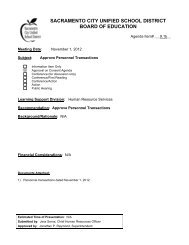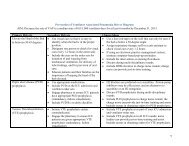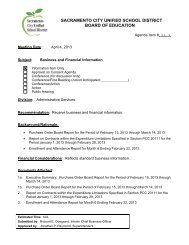Kenneth Alexander, MS, RRT Vice President of Quality and ...
Kenneth Alexander, MS, RRT Vice President of Quality and ...
Kenneth Alexander, MS, RRT Vice President of Quality and ...
You also want an ePaper? Increase the reach of your titles
YUMPU automatically turns print PDFs into web optimized ePapers that Google loves.
<strong>Kenneth</strong> <strong>Alex<strong>and</strong>er</strong>, <strong>MS</strong>, <strong>RRT</strong><br />
<strong>Vice</strong> <strong>President</strong> <strong>of</strong> <strong>Quality</strong> <strong>and</strong> Regulatory Activities<br />
Louisiana Hospital Association<br />
As vice president <strong>of</strong> quality <strong>and</strong> regulatory activities, Ken<br />
<strong>Alex<strong>and</strong>er</strong> is responsible for the Louisiana Hospital<br />
Association’s emergency preparedness activities. Ken is<br />
integrally involved in the planning, execution <strong>and</strong> support<br />
<strong>of</strong> Louisiana’s Medical Institution Evacuation Plan,<br />
Sheltering in Place plan, <strong>and</strong> state m<strong>and</strong>ated hospital<br />
reporting plan. During hurricanes Gustav, Ike <strong>and</strong> Isaac,<br />
Ken manned the state Emergency Operations Center.<br />
During hurricanes Katrina <strong>and</strong> Rita, Ken was a hospital<br />
CEO, maintaining routine hospital operations while<br />
sheltering in place <strong>and</strong> serving as a medical special needs<br />
shelter for 35 Katrina evacuees. Most <strong>of</strong> his 35+ year<br />
career has been spent in the hospital industry where he<br />
has served a variety <strong>of</strong> roles ranging from care delivery to<br />
executive management.
Disaster Planning,<br />
Response & Recovery:<br />
Louisiana Lessons Learned<br />
<strong>Kenneth</strong> <strong>Alex<strong>and</strong>er</strong>, <strong>MS</strong>, <strong>RRT</strong><br />
<strong>Vice</strong> <strong>President</strong> <strong>of</strong> <strong>Quality</strong> <strong>and</strong> Regulatory Activities<br />
Louisiana Hospital Association<br />
Ken <strong>Alex<strong>and</strong>er</strong>, <strong>MS</strong>, <strong>RRT</strong><br />
<strong>Vice</strong> <strong>President</strong> <strong>of</strong> <strong>Quality</strong> & Regulatory Activities<br />
Louisiana Hospital Association<br />
kalex<strong>and</strong>er@lhaonline.org<br />
www.lhaonline.org<br />
Medical Institution Evacuation Plan<br />
Sheltering In Place<br />
Power Management
What Are We Talking About?<br />
• Louisiana’s experiences through 5 major hurricanes in 7 years<br />
• Not even counting massive oil spills <strong>and</strong> river flooding, etc!!<br />
• And a little about our last year’s visitor Isaac<br />
• Medical Institution Evacuation Planning<br />
• Pre-Event Planning helps develops Post-Event Recovery<br />
• Sheltering in Place<br />
• Planning <strong>and</strong> Decisions<br />
• Facility Recovery<br />
• Power Management Issues<br />
• Relationships between state & federal agencies <strong>and</strong> LHA<br />
6<br />
Louisiana - 2005-2012<br />
5 Major Hurricanes, Massive Oil Spill,<br />
<strong>and</strong> Record Level Flooding<br />
7<br />
Hurricane Katrina<br />
Hurricane Katrina hits the Gulf Coast on the<br />
morning <strong>of</strong> August 29, 2005
9<br />
New Orleans Superdome Before……<br />
Downtown Before…..<br />
10<br />
New Orleans Superdome After……<br />
University<br />
Hospital<br />
11
12<br />
13<br />
14
15<br />
16<br />
17
18<br />
19<br />
20
21<br />
Fast Forward Three Years….<br />
• Realistic Expectation developed: blend <strong>of</strong> both<br />
Medical Institution Evacuation Plan (MIEP) <strong>and</strong><br />
Shelter in Place (SIP)<br />
• Developed a comprehensive MIEP <strong>and</strong> SIP<br />
protocols<br />
• Patient Tracking Improvements<br />
• Hospital Needs/Requests Process Improvements<br />
• Communications Improvements<br />
• Post-Storm Recovery Improvements<br />
22<br />
And then…<br />
déjà vu all over again…<br />
but different!<br />
23
Background Information<br />
Gustav/Ike<br />
• GOHSEP Activation<br />
• Start Date: Tuesday, August 26, 2008<br />
• End Date: Friday, September 19, 2008<br />
• Declaration <strong>of</strong> Emergency<br />
• State: Wednesday, August 27, 2008 at 1600 hours<br />
• Federal: Wednesday, August 27, 2008<br />
• L<strong>and</strong>fall Dates<br />
• Gustav: Monday, September 1, 2008<br />
• Ike: Saturday, September 13, 2008<br />
24<br />
Why Does Louisiana Evacuate?<br />
• Burning question for partnering states<br />
• Why use ND<strong>MS</strong>?<br />
• Why not just move South to North?<br />
• Capacity Limited in Northern Regions<br />
• Power outages, flooding impacts traditional<br />
sheltering areas<br />
• Current system level MOU’s for transfers<br />
• HCA, Christus, LifePoint, others<br />
25<br />
Abbreviated Timeline<br />
H-hour:<br />
• 120: Lean Forward! Email alerts, notifications distributed, communications check<br />
• 72: Flag goes up! All levels <strong>of</strong> government (local, state, federal) must watch this<br />
storm <strong>and</strong> be ready to mobilize an AMP. Form 1 is used to identify potential<br />
volume <strong>of</strong> patients so that number <strong>of</strong> aircraft can be estimated <strong>and</strong> organized for<br />
potential activation.<br />
• 72 – 54: Continuous updates to Form 1. Refinement <strong>of</strong> data as threat becomes<br />
more imminent. Based on the direction <strong>and</strong> threat <strong>of</strong> the storm, AMP(s) are<br />
activated.<br />
• 54: “No-kidding” numbers are ascertained.<br />
• 48: Wheels-up! The first load <strong>of</strong> patients should be en route to FCC.<br />
• 18: Clearing the Battlefield. A meter-check is determined to see how many<br />
patients still require evacuation. This is the last chance to make any corrective<br />
actions. SMART listing identified.<br />
• 12: AMPs CLOSED<br />
26
GUSTAV Medical Institution Evacuation: August 31, 2008<br />
• State/hospitals waited for almost two days before C-130s <strong>and</strong><br />
AE crews showed up at Region 5 AMP <strong>and</strong> Region 1 AMP.<br />
Region 5 AMP<br />
Chennault Airport<br />
124 ND<strong>MS</strong> patients Regions 4<br />
Acadiana Airport<br />
34 Homebound patients<br />
Regions 3<br />
Moved by ground/air<br />
ambulances the ND<strong>MS</strong><br />
patients <strong>and</strong> homebound<br />
patients to Region 1<br />
Regions 1 AMP<br />
Lakefront Airport<br />
302 ND<strong>MS</strong> patients<br />
81 Homebound pts.<br />
27<br />
Gustav/Ike: Transportation<br />
• Total Credentialed Ambulances <strong>and</strong> Para-transits<br />
• 464 Federal air, ground <strong>and</strong> para-transit seats<br />
• 88 Louisiana State<br />
• 94 EMAC ambulances from other States<br />
• These assets were used for evacuation, surge,<br />
transport, sheltering, medical support, search <strong>and</strong><br />
rescue as well as repatriation post-hurricane.<br />
28<br />
Evacuation <strong>and</strong> Sheltering<br />
• M<strong>and</strong>atory Evacuations Orders<br />
• Gustav: 17 parishes<br />
• Ike: 3 parishes<br />
• Number <strong>of</strong> People Sheltered<br />
(numbers are approximate <strong>and</strong> sourced from GOHSEP rolling sitreps)<br />
Gustav Ike<br />
Gen Pop 25,000 2,841<br />
CTNS 37,375 1,620<br />
<strong>MS</strong>NS/F<strong>MS</strong> 7,637 329<br />
29
Hurricane Gustav<br />
• 1.8 million people evacuated the coast<br />
• Over 400 spreadsheets generated for MIEP<br />
• Over 1000 patients evacuated from hospitals<br />
• Over 70 hospitals partially or fully evacuated<br />
• Pre <strong>and</strong> post storm<br />
• No electricity statewide – 98% <strong>of</strong> metered power<br />
• Labeled a “Power Event”– HVAC was issue<br />
• State leadership had insatiable desire for data<br />
30<br />
Hospital to Hospital Private<br />
Evacuation is Easiest to Manage<br />
31<br />
Patient Evacuation System Via ND<strong>MS</strong><br />
LOCAL<br />
HOSP<br />
State EOC/JPMT<br />
M<br />
S<br />
N<br />
Regional Coordinator/<br />
AE Liaison<br />
P<br />
M<br />
R<br />
<strong>MS</strong>N<br />
PMR<br />
Mission<br />
Built<br />
GPMRC<br />
P<br />
M<br />
R<br />
AMC<br />
(TACC)<br />
M<br />
S<br />
N<br />
Crews<br />
Alerted<br />
Mission Specifics<br />
(<strong>MS</strong>N #, Times, Etc.)<br />
APOE/AMP<br />
Ambulance<br />
Control/Staging<br />
TRANSCOM<br />
CRE<br />
Airfield<br />
Incident<br />
Comm<strong>and</strong>er/<br />
AE CDR Element<br />
AELT<br />
MASF<br />
CCATT<br />
ND<strong>MS</strong> HOSPITALS<br />
APOD/FCC<br />
32
The Realities <strong>of</strong> Air Evacuation!<br />
33<br />
Repatriation <strong>of</strong> ND<strong>MS</strong> <strong>and</strong> <strong>MS</strong>NS patients<br />
State<br />
Number <strong>of</strong> Patients<br />
Total Number<br />
Received<br />
Total Patients<br />
Deceased<br />
Total Patients Left to<br />
be Received<br />
Total Patients in CareFlite<br />
Que<br />
Alabama 9 9 0 0 0<br />
Arkansas 325 304 21 0 0<br />
Kentucky 3 3 0 0 0<br />
Mississippi 98 98 0 0 0<br />
North Carolina 1 1 0 0 0<br />
Oklahoma 30 29 1 0 0<br />
Tennessee 8 8 0 0 0<br />
Texas 86 84 2 0 0<br />
Total 560 536 24 0 0<br />
Source: DHH Repatriation Cell, October 2, 2008 (Kathy Kliebert)<br />
34<br />
Shelter in Place<br />
Issues <strong>and</strong> Planning<br />
35
Shelter in Place Concerns:<br />
Pre-Storm Planning HUGE factor in<br />
Post-Storm Recovery Success<br />
• Facility Hardening<br />
• Staffing to support continued operations<br />
• Generators to support HVAC systems<br />
• Fuel for generators<br />
• Oxygen for Hospitals <strong>and</strong> Shelter<br />
• Homebound without power for concentrators<br />
• 7 Days Supplies<br />
• Security<br />
• Communication with Regulators<br />
36<br />
Shelter in Place Staffing<br />
Immediate Post Storm Recovery Issues<br />
• Sufficient staff?<br />
• Did Staff evacuate?<br />
• Areas <strong>of</strong> possible short-falls?<br />
[Categories: physicians, nurses, respiratory<br />
therapists, lab, X-ray technicians, pharmacists,<br />
facilities support, perimeter security, interior<br />
security, etc.]<br />
• Sheltering for staff? Families? Pets?<br />
• Civil/Criminal Immunity Provisions?<br />
• In Louisiana, referred to as the “Anna Pou”<br />
factor.<br />
37<br />
Shelter in Place Supplies – 7 Days<br />
• Food for patients <strong>and</strong> staff<br />
• Potable water for patients <strong>and</strong> staff<br />
• Oxygen-Bulk <strong>and</strong> tank<br />
• Extra tanks (“E” & “H”) w/ regulators as back up if<br />
bulk system fails<br />
• Linen for patients <strong>and</strong> staff<br />
• General Medical Supplies<br />
• Pharmaceuticals<br />
• Blood<br />
• Sanitation Supplies & Equipment<br />
• Decontamination Facilities & Equipment<br />
• Fuel for Generator<br />
38
MIEP/Shelter in Place Planning<br />
• Facility checklist reviewed annually at a minimum<br />
• Know resource requirements<br />
• Have a post event evacuation plan<br />
• Recommend 7 days <strong>of</strong> supplies – maybe longer<br />
• Rumors abound – verify, verify <strong>and</strong> confirm<br />
• Communications Required – 800MHz Radios or??<br />
• Added Security<br />
• ELECTRICITY IS KING – Maintain Generator!!!!<br />
39<br />
Shelter in Place<br />
Power Related Issues<br />
40<br />
41
42<br />
Gustav/Ike: Hospital Power Outages<br />
Post Event Greatly Impacted Recovery<br />
Region Gustav Ike Total<br />
Region 1 1 0 1<br />
Region 2 12 0 12<br />
Region 3 5 2 7<br />
Region 4 9 3 12<br />
Region 5 0 1 1<br />
Region 6 2 1 3<br />
Region 7 0 4 4<br />
Region 8 0 1 1<br />
Region 9 1 0 1<br />
TOTAL 30 12 42<br />
43<br />
What Does Your Generator Power?<br />
• HVAC<br />
• Chillers<br />
• Life support equipment<br />
• Surgery <strong>and</strong> sterile surgical equipment<br />
• Patient isolation rooms<br />
• Pharmacy <strong>and</strong> materials refrigeration<br />
• MRI <strong>and</strong> CT scans<br />
• Food service equipment<br />
• Water pumps<br />
• Elevators<br />
• Automated security lock-down<br />
• What is the one thing every generator needs?<br />
44
FUEL………….<br />
45<br />
<strong>MS</strong>TAT – At a Glance Status Review<br />
46<br />
Monitor Fuel Plus Other Critical<br />
“Utilities”<br />
The facility can define the utility account<br />
information for each utility (provider name <strong>and</strong><br />
account number)<br />
Assists utility providers to prioritize service<br />
restoration<br />
47
Region or State at a Glance<br />
48<br />
Relationships – Yes, Virginia, We Can<br />
Hold H<strong>and</strong>s <strong>and</strong> Sing Kumbaya!<br />
49<br />
Building Trust – Mars vs Venus<br />
• EVERYONE truly wants to help the patients – Work in progress<br />
underst<strong>and</strong>ing that hospitals are from Mars <strong>and</strong> the “Feds” are<br />
from Venus – <strong>and</strong> appreciating the differences<br />
• Hospitals trust the LHA – They don’t necessarily trust the<br />
government<br />
• The LHA underst<strong>and</strong>s the need for <strong>and</strong> value added by the<br />
various state <strong>and</strong> federal partners <strong>and</strong> vice versa<br />
• Hurricane Katrina forced ALL the players to work together during<br />
the acute stages <strong>of</strong> the crisis<br />
• LHA having a seat at the EOC helps accomplish mutual need<br />
• A guarded relationship emerged <strong>and</strong> has been fostered <strong>and</strong> grown<br />
50
Wrapping Up<br />
51<br />
Issues Requiring Advanced<br />
Thought/Planning<br />
“Coulda, Shoulda, Woulda”<br />
• FEMA Rules/Regulations – experience with reimbursement <strong>and</strong><br />
funding<br />
• Federal Language – experiences with communication <strong>of</strong> data –<br />
terminology, acronym soup!!!<br />
• Patient Tracking<br />
• Comprehensive patient database (At Risk Registry)<br />
• Tracking for evacuated patients – Who went where?!<br />
• Transportation<br />
• EMAC – statewide contract for ambulances<br />
• Private contracts<br />
• Politics<br />
• Local vs. Parish (county) vs. State vs. Federal<br />
• Message needs to be consistent<br />
52<br />
Issues Requiring Advanced<br />
Thought/Planning<br />
“Coulda, Shoulda, Woulda”<br />
• Consistent tracking <strong>and</strong> reporting <strong>of</strong> hospital requests<br />
(fuel, food, water) – La. Developed E<strong>MS</strong>TAT (now <strong>MS</strong>TAT)<br />
• Blessing <strong>and</strong> a Curse!<br />
• Power needs<br />
• Location <strong>of</strong> generator, damage resistance, transfer switch<br />
configuration <strong>and</strong> location<br />
• Is there a database <strong>of</strong> generator info at the State or CHA?<br />
• Oxygen, Fuel, Potable Water<br />
• Organization <strong>of</strong> volunteer vs. paid medical personnel<br />
• Civil <strong>and</strong> Criminal Immunity Issues (i.e., Anna Pou)<br />
53
Bottom Line – “Clif Notes”<br />
• Managing your Pre-Event plan effectively addresses many<br />
Post-Event Recovery Issues<br />
• Federal Partners – well-intentioned with some good people, but<br />
a bureaucracy is a bureaucracy….wheels can turn s.l.o.w.l.y.<br />
• C<strong>MS</strong> <strong>and</strong> State Regulators – waivers, re-occupy, etc.<br />
• Reimbursement – ‘Nuff Said………………..<br />
• Timelines can be deceptive – we planned for longer H-hour<br />
trigger points, <strong>and</strong> dealt with numerous delays<br />
• Staffing, Staffing, Staffing<br />
• Medical Malpractice protection for hospital personnel<br />
• Power, Fuel, Water, Oxygen, Food, Supplies<br />
• Work at working together – everyone wins<br />
54<br />
LHA Online Resources<br />
www.lhaonline.org<br />
55<br />
56
Thank You!<br />
<strong>Kenneth</strong> E. <strong>Alex<strong>and</strong>er</strong><br />
<strong>Vice</strong> <strong>President</strong> <strong>of</strong> <strong>Quality</strong> & Regulatory Activities<br />
E-mail: kalex<strong>and</strong>er@lhaonline.org<br />
Louisiana Hospital Association<br />
9521 Brookline Avenue ● Baton Rouge, LA 70809<br />
Phone: (225) 928-0026 Fax: (225) 923-1004<br />
57





